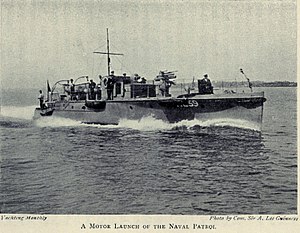Motor Launch
 A WW I motor launch - ML 59
| |
| Class overview | |
|---|---|
| Builders | Elco |
| Operators | |
| Built | 1915–1918 |
| In commission | 1915–1920s |
| Completed | 580 |
| General characteristics ML.1–50 series | |
| Type | Motor launch |
| Displacement | 34 t |
| Length | 75ft |
| Propulsion | Petrol engine |
| Speed | 19 kn (35 km/h) |
| Complement | 8 |
| Armament |
|
| General characteristics ML.51–550 series | |
| Type | Motor launch |
| Displacement | 37 t |
| Length | 86ft |
| Propulsion | Petrol engine |
| Speed | 19 kn (35 km/h) |
| Complement | 6 |
| Armament |
|
| General characteristics ML.551–580 | |
| Type | Motor launch |
| Displacement | 37 t |
| Length | 80ft |
| Speed | 19 kn (35 km/h) |
| Complement | 8 |
| Armament |
|
A Motor Launch (ML) is a small military vessel in Royal Navy service. It was designed for harbour defence and submarine chasing or for armed high-speed air-sea rescue. Some vessels for water police service are also known as motor launches.
World War I service[]
Although small by naval standards, it was larger than the preceding steam or diesel-engined harbour launches of 56ft and coastal motor boats of 40 and 55 ft length. The first motor launches entered service in the First World War. These were five hundred and eighty 80-foot-long (24 m) vessels built by the US Elco company for the Admiralty, receiving the numbers ML-1 to ML-580. They served with the Royal Navy between 1916 and the end of the war, defending the British coast from German submarines.[1] Some of the earliest examples, including ML 1, also served in the Persian Gulf from June 1916. After the Armistice of 11 November 1918 a flotilla of 12 Royal Navy motor launches travelled down the Rhine performing duty as the .[2] The only known surviving example of a World War I era motor launch is ML-286, which now lies in a poor condition on the banks of the River Thames.
World War II types[]

| Type | Length | Weight | Speed | Built | Total | Lost | Designed for |
|---|---|---|---|---|---|---|---|
| Fairmile A motor launch | 110 ft | 57 tons | 25 knots (46 km/h) | 1939 | 12 | Submarine chasing, later minelaying | |
| Fairmile B motor launch | 112 ft (34 m) | 85 tons | 20 knots (37 km/h) | 1940-45 | 1,284 | Submarine chasing, many later roles including air-sea rescue | |
| Harbour Defence Motor Launch | 72 ft (22 m) | 54 tons | 12 knots (22 km/h) | 1940-45 | 486 | 47 | Defending harbours; anti-submarine |
| BPBC Type Two 63 ft High Speed Launch " Whaleback" | 63 ft (19 m) | 21.5 tons | 36 knots (67 km/h) | 1940-42 | 70 | RAF air-sea rescue downed aircrew, particularly in the English Channel |
The BPBC Type Two was succeeded by the Type Three 68 ft "Hants and Dorset".
Post-war, many motor launches were taken on as pleasure boats. A number of them are on the National Register of Historic Vessels.[3]
See also[]
- Harbour launch
- High-speed launch
- Motor gunboat
- Motor torpedo boat
- Coastal Forces of the Royal Navy
- R boat – German World War II equivalent
- Dark-class fast patrol boat
References[]
- ^ Gardiner, p. 101
- ^ Jeffrey Charles. "The Rhine Patrol Flotilla Part I: Establishment of the Flotilla".
- ^ Gardiner and Chesneau, p. 71
- Gardiner, Robert, Conway's All the World's Fighting Ships 1906–1921 Conway Maritime Press, 1985. ISBN 0-85177-245-5.
- Gardiner, Robert and Chesneau, Roger, Conway's All the World's Fighting Ships 1922–1946, Conway Maritime Press, 1980. ISBN 0-83170-303-2.
External links[]
- UK National Register of Historic Vessels
- Naval Museum of Manitoba
- Juno Beach
- A Short History of HMS St Christopher. Royal Navy Coastal Forces training base, mainly for MLs
- Stoker Harold Siddall Royal Navy, his service in ML.1030 and capture in Crete 1941
- "The Movies" A Motor Launch History
- Ships of the Royal Navy
- Submarine chaser classes
- Patrol boat classes
- Auxiliary search and rescue ship classes
- Boat types
- Military boats